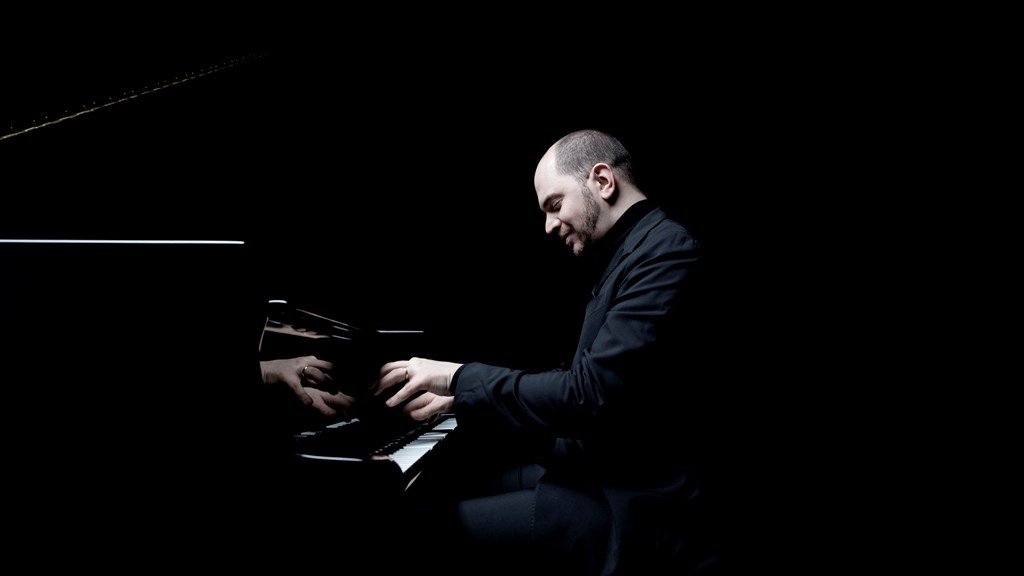Prior to conducting the Brahms First Piano Concerto with Glenn Gould and the New York Philharmonic in 1962, Leonard Bernstein said, “You are about to hear a rather unorthodox performance… [and] I cannot say I am in total agreement with Mr Gould’s conception.” Although my sentiments were perhaps not as extreme as Bernstein’s, the thought echoed in my mind throughout the concert, part of the Sydney Symphony Orchestra’s Keys to the City Festival.
 Kirill Gerstein. Photo © Marco Borggreve
Kirill Gerstein. Photo © Marco Borggreve
Liszt’s Transcendental Étude No 7, Eroica, was set up as an introduction to Beethoven’s Fifteen Variations and Fugue. Calling for incredibly virtuosic runs and fast chord progressions, the Eroica was a work that showed off Gerstein’s technical dexterity, even though there were times when the direction and breathing between rests seemed ambiguous.
Without removing his hands from the keys after Liszt’s final E Flat chord, Gerstein shot straight into the Beethoven. Although the composer was known to be a bold, passionate man, his works often reflecting that, he also carried great tenderness and sensitivity. Gerstein occasionally made the accents in an already dynamically varied work blunter than Beethoven calls for, while tempo in each variation tended to shift for no real significance and the phrased pauses and silences came across carelessly. Accompanied by the pianist’s audible foot slaps on the pedal, these things detracted from the overall experience.
However, toward the latter half of the Variations, Gerstein’s playing began to build into a truly cohesive exploration of Beethoven’s work. Although his unrestrained style, perhaps informed by his jazz training, was not so suited to my taste, Gerstein’s interpretation echoed what Bernstein said at that 1962 concert: “[Mr Gould is] so valid and serious an artist that I must take seriously anything he conceives in good faith…[and] because we can all learn something from this extraordinary artist who is a thinking performer.”
With that said, there was no doubt the quality of the evening increased steadily after this, due in large part to the well-thought out program. The long second-half filled with shorter works built to Ravel’s Le Tombeau de Couperin, and the shift from the heroic colours of Beethoven began with the only piano sonata Janáček wrote, From the Street. Opening with a lamenting broken chord, Gerstein’s delicate and well-controlled touch set an elegiac atmosphere which was heightened by a later series of arpeggiatic flourishes and embellishments across the piano. The ending was magical, Gerstein holding onto the last chord until its ringing overtones were no longer audible, the audience waiting with bated breath to applaud.
Adès’ Berceuse from The Exterminating Angel, which was premiered in Australia by Gerstein in his Melbourne recital, was a perfect transition into impressionism after a scintillating performance of Liszt’s bass heavy and march-like middle section in his Funérailles. Berceuse had the balance of chromatic chords and repetition found in the Liszt, while also introducing a multitude of colours and harmonies which continued in the Debussy that followed.
Debussy’s Élégie, Les soirs illumines par l’ardeur du charbon (Evenings lit by burning coals) and Komitas’ folk tunes Shushiki and Unabi: Grave et gracieux from his six dances were shrewdly placed one after the other, further bringing the audience away from the morbid mood of the preceding Classical and Romantic pieces to one of picturesque harmonies and colours.
Gerstein brought Debussy’s scenic, colourful world to life with a playful and sensitive control of both touch and sound, while his playing of the Komitas temporarily disrupted the second half’s impressionism with its simple melodic line accompanied by fast ornamental embellishments in the right hand to create the folk and dance characters of the composer’s music.
Then finally the long awaited Le Tombeau de Couperin, a work written in memory of Ravel’s friends lost to war. It is a work of multiple facades, with seemingly delicate and poignant colours masked within melancholia, hints of subdued anger only drawn out in the finale, the Toccata. Gerstein gave a masterful performance of this mammoth work, playing with sensitivity but giving it the magnitude of a symphony. The third movement, Forlane, which contains accidentals and jazz-like chords, was where Gerstein’s jazz background got the chance to shine. The technically challenging Toccata, with its singular lyrical voice, reminiscent of a flute, sang loud and clear amongst the repetitive rhythmic oscillations.
The enraptured audience clearly did not want him to leave as they pushed him for two more encores, an incredibly fast rendition of Bach-Busoni’s Choral Prelude No 4 and Chopin’s Waltz in A Flat. It was a brilliant conclusion to a night that provided new insight into age-old works.












Comments
Log in to join the conversation.